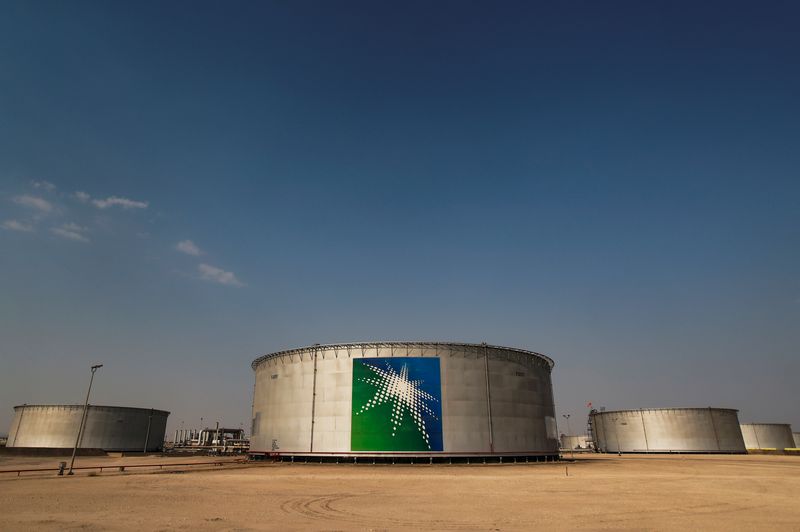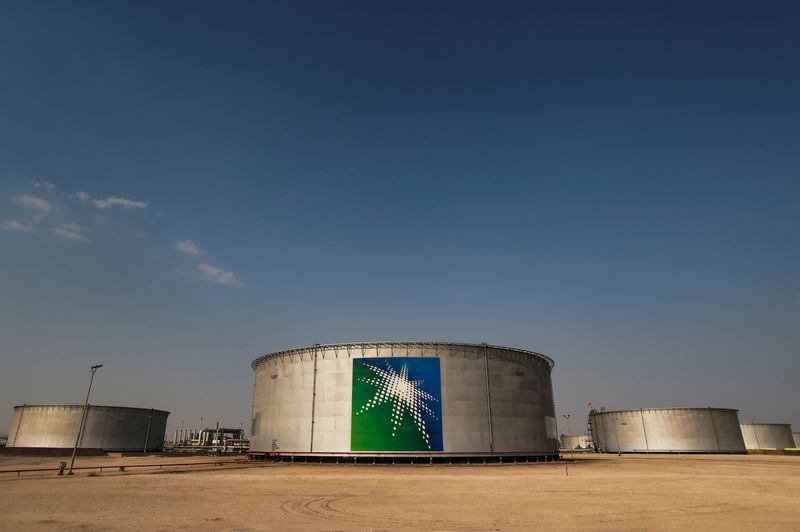Commodities
Oil rises for 6th straight week as global supplies tighten


© Reuters. FILE PHOTO: A view shows branded oil tanks at Saudi Aramco oil facility in Abqaiq, Saudi Arabia October 12, 2019. REUTERS/Maxim Shemetov/File Photo
By Shariq Khan
(Reuters) -Oil prices rose more than a dollar a barrel on Friday to record a sixth consecutive week of gains, after top producers Saudi Arabia and Russia extended supply cuts through September, adding to undersupply concerns.
futures rose $1.10, or 1.3%, to settle at $86.24 a barrel, while the U.S. West Texas Intermediate crude gained $1.27, or 1.6%, to close at $82.82 a barrel. Both benchmarks hit their highest levels since mid-April on Friday.
Saudi Arabia on Thursday extended a voluntary oil production cut of 1 million barrels per day to the end of September, keeping the door open for another extension. Russia has also elected to reduce its oil exports by 300,000 barrels per day next month.
“With the production cut extended, we anticipate a market deficit of more than 1.5 million barrels per day (bpd) in September, following an estimated deficit of around 2 million bpd in July and August,” UBS analysts wrote in a note.
On the demand front, global oil consumption could grow by 2.4 million bpd this year, Russian Deputy Prime Minister Alexander Novak said on Friday after a ministerial panel meeting of the OPEC+ group – the Organization of the Petroleum Exporting Countries and allies.
The meeting yielded no changes to output policy. The panel noted that it could take additional measures at any time, which could mean additional cuts if market conditions worsen, the UBS note added.
UBS said it expects Brent prices to trade in the $85 to $90 per barrel range over the coming months.
Earlier on Wednesday, the U.S. Energy Information Administration reported that the country’s inventory declined by a record 17 million barrels last week as exports and refiners’ input of crude oil ramped up in the heart of summer travel season.
Weighing on oil prices, data released on Friday showed the U.S. economy maintained a moderate pace of job growth in July, but solid wage gains and a decline in the unemployment rate pointed to continued tightness in labor market conditions.
Additionally, the downturn in euro zone business activity worsened more than initially thought in July and the Bank of England raised its interest rate to a 15-year peak on Thursday.
Commodities
Oil prices rise; U.S. crude inventories plunge, Russia-Ukraine truce eyed
Commodities
India’s Reliance to stop buying Venezuelan oil over US tariffs, sources say
Commodities
Oil prices climb on Venezuela supply worries

 Forex3 years ago
Forex3 years agoForex Today: the dollar is gaining strength amid gloomy sentiment at the start of the Fed’s week

 Forex3 years ago
Forex3 years agoUnbiased review of Pocket Option broker

 Forex3 years ago
Forex3 years agoDollar to pound sterling exchange rate today: Pound plummeted to its lowest since 1985

 Forex3 years ago
Forex3 years agoHow is the Australian dollar doing today?

 Cryptocurrency3 years ago
Cryptocurrency3 years agoWhat happened in the crypto market – current events today

 World3 years ago
World3 years agoWhy are modern video games an art form?

 Commodities3 years ago
Commodities3 years agoCopper continues to fall in price on expectations of lower demand in China

 Economy3 years ago
Economy3 years agoCrude oil tankers double in price due to EU anti-Russian sanctions

























